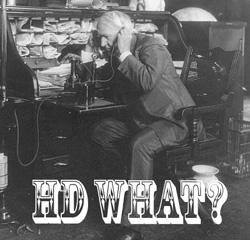People who recall the era of analog phones and physical switches often feel nostalgic about the superior audio quality of those systems. The conversations back then possessed a clarity and immediacy that has largely vanished in recent times, though this might be changing soon. A new movement is underway to enhance the fidelity of VoIP calls significantly, aiming to make current phones seem primitive in comparison.
This advancement is known as high-definition audio or HD Voice, a term used by Polycom, a manufacturer of IP phones equipped with this technology. The goal is to overcome the gradual decline in voice clarity that came with the digital revolution and establish a new, unparalleled standard.
A similar shift occurred in the radio industry. Anyone familiar with the large console radios from the 1930s or the tabletop models from the 1950s knows that AM radio can deliver remarkably lifelike sound. The introduction of transistor radios, however, led to smaller speakers, which limited the range of audible frequencies. The resulting loss of low-end frequencies was described as “tinny.” Car radios further restricted the frequency range by suppressing high frequencies to minimize noise and static. It took the emergence of FM radio to expand the frequency range and eliminate background noise, paving the way for high-fidelity audio.
Old phones were remarkably simple devices. A carbon microphone and an electromagnetic earphone, powered by a battery at the telephone exchange, were connected to a similar phone on the other end. The absence of electronics in the circuit, combined with a mechanical switch at the exchange that simply connected phones, resulted in a richness of sound that made local conversations feel almost like in-person interactions.
The author vividly remembers noticing a difference in audio quality when their employer replaced their old phone system with a new digital PBX system. Calls on the new phones sounded slightly muffled, lacking the previous clarity. The difference was subtle but perceptible. Although there was no noticeable noise or distortion, something was amiss.
The missing element, as the author later realized, was a portion of the audio frequency range. This wasn’t solely due to digital technology. It began with long-distance calls. Analog carrier multiplexing, used to transmit multiple conversations over copper wires and microwave links, required filters to prevent interference. Research led to the adoption of a standard frequency range of 300 to 3400 Hz for phone calls. Frequencies above 3400 Hz, while contributing to naturalness, aren’t crucial for speech intelligibility. By filtering them out, more phone channels could be squeezed onto a single trunk, and annoying high-frequency hiss could be eliminated. Similarly, frequencies below 300 Hz, while adding distinctiveness to voices, aren’t essential for comprehension. Removing them minimized problems caused by power line interference.
This standard persisted even with the transition from analog to digital technology, ensuring compatibility and consistency. Digital technology significantly improved long-distance calls, particularly international ones, by eliminating the noise and crosstalk common in the analog era. However, this advantage diminished with the advent of mobile phones, which can be susceptible to noise and dropped calls.
Early VoIP implementations exacerbated the situation. Packet transmission introduced distortion from lost packets and variable transmission times (jitter). Latency, a time delay in network transmission, was virtually nonexistent in analog and TDM telephony. Now, poorly implemented VoIP systems often exhibit clipping, making it difficult for two people to speak simultaneously.
HD audio aims to revolutionize voice quality by establishing a new, superior standard. This is achieved using a wideband CODEC (Coder/Decoder) to handle the conversion between analog signals from the microphone and earpiece and digital signals for transmission. The new G.722 Codec doubles the bandwidth to 7 kHz, which can be extended up to 20 kHz, matching the quality of CDs and digital FM radio.
HD Voice is available today through Polycom business phones and service providers like RealLinx, which offer hosted PBX systems and carefully managed bandwidth to ensure high-quality audio. However, this technology only reaches its full potential within organizations or among users equipped for HD Voice and the G.722 Codec. When one party uses traditional telephone technology, the system defaults to the universal G.711 telco standard and its limited frequency range.
Despite this limitation, implementing higher-fidelity audio within an organization can enhance conversation clarity, preserving subtle vocal nuances often lost in traditional phone calls. This is particularly beneficial as budget constraints and time limitations lead to fewer face-to-face meetings and a greater reliance on audio and video conferencing.
Businesses considering replacing outdated phone systems or purchasing equipment for new ventures or locations are encouraged to explore the benefits of HD Voice. Instead of settling for outdated technology, embrace a solution that offers a competitive edge at a lower overall cost. Before making a decision, explore the pricing and features of HD Voice Hosted PBX VoIP telephone systems.


